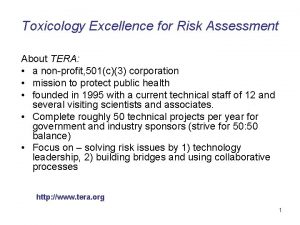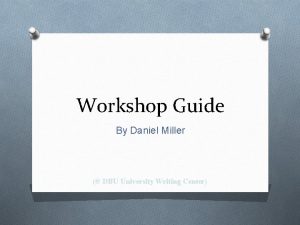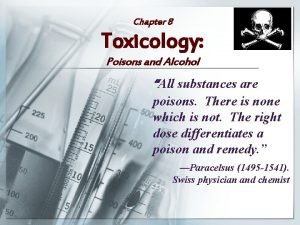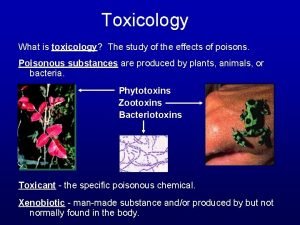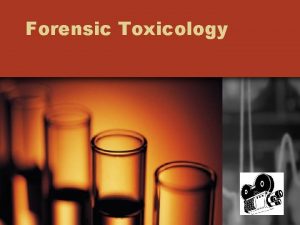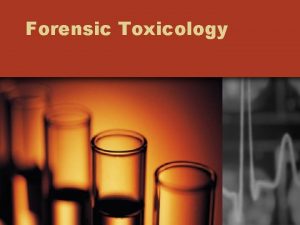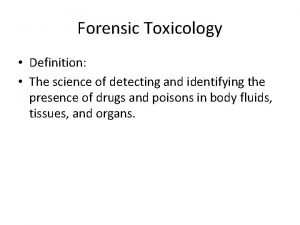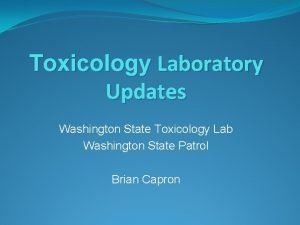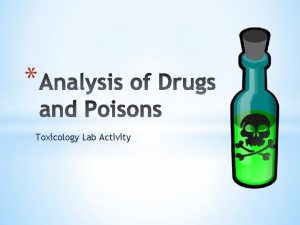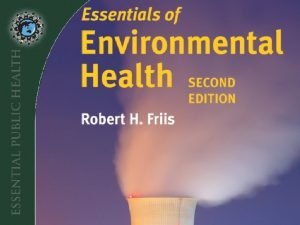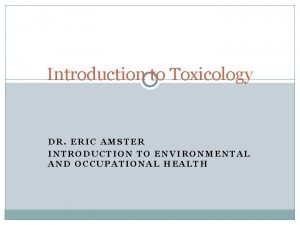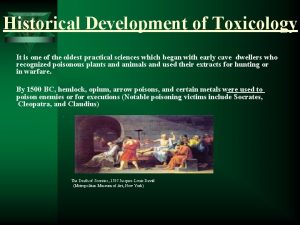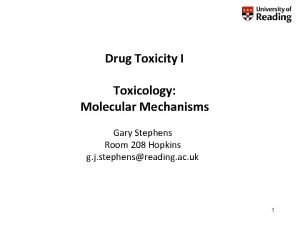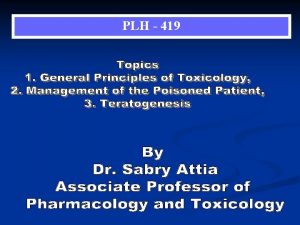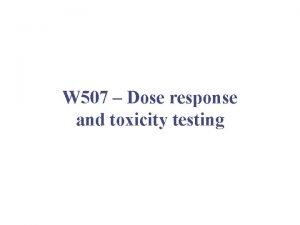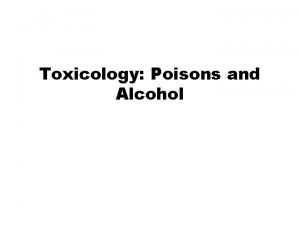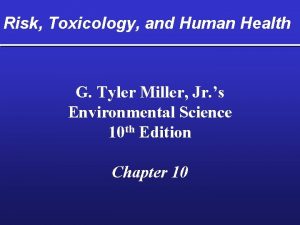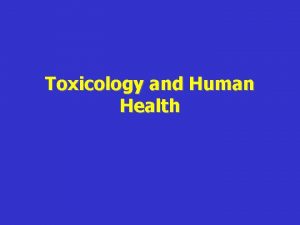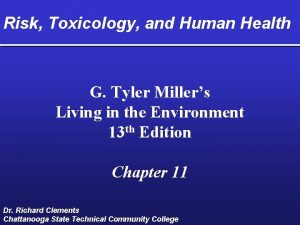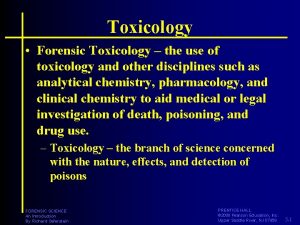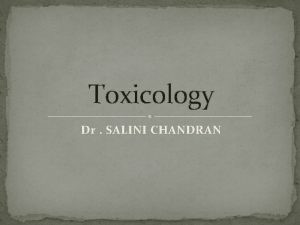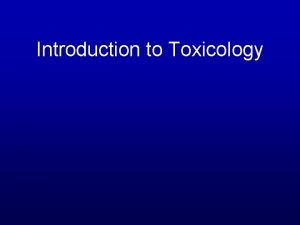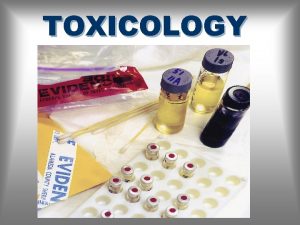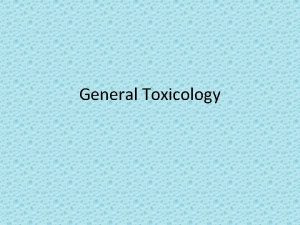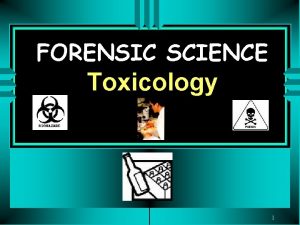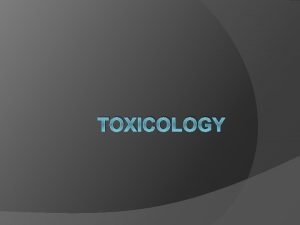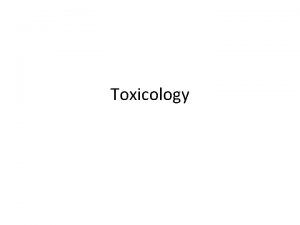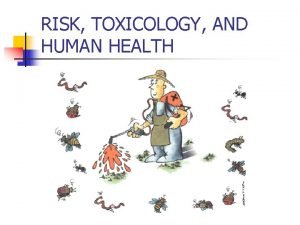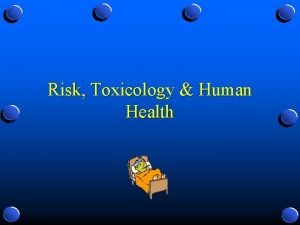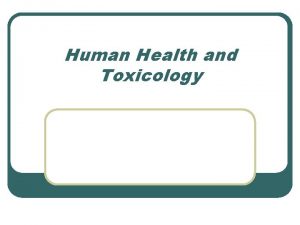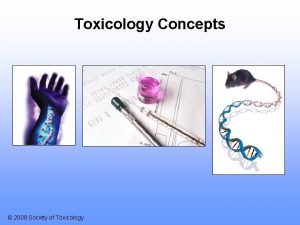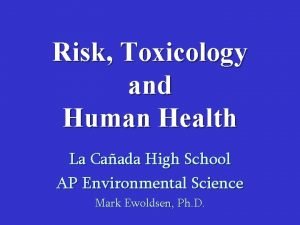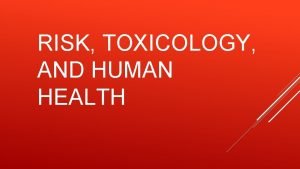Risk Toxicology and Human Health G Tyler Miller





























- Slides: 29

Risk, Toxicology, and Human Health G. Tyler Miller, Jr. ’s Environmental Science 10 th Edition Chapter 10

Key Concepts Ø Types of hazards people face Ø Defining toxicology and measuring toxicity Ø Types and measurement of chemical hazards Ø Types of biological hazards (diseases) Ø Risk estimation, management, and reduction

The Big Killer Ø Tobacco Ø Health hazards Ø Nicotine Ø Costs of smoking Ø Antismoking programs Fig. 10 -1, p. 203

Risk and Probability Ø Risk assessment Ø Risk management Ø Probability Fig. 10 -2, p. 204

Major Types of Hazards Ø Cultural Ø Chemical Ø Physical Ø Biological Fig. 19 -1 p. 409

Toxicology Ø Toxicity Ø Dosage Ø Bioaccumulation Ø Biomagnification Ø Synergism Ø Response Ø Acute effect Ø Chronic effect

Variations in Sensitivity to a Toxin within a Population Number of individuals affected © 2004 Brooks/Cole – Thomson Learning Very sensitive 0 Majority of population 20 40 Dose (hypothetical units) Very insensitive 60 80 Fig. 10 -3, p. 205

Bioaccumulation and Biomagnification Fig. 10 -4, p. 205

Concerns about Trace Levels of Toxic Chemicals Ø Concentration determines toxicity Ø “Dose makes the poison” Ø Tolerance varies with individuals Ø Natural isn’t always safe Ø Synthetic isn’t always bad Ø Analytical methods are improving

Poisons Ø Poison Ø Median lethal dose (LD 50) Also see Table 10 -1, p. 207 Fig. 10 -5, p. 206

Estimating Toxicity Ø Case reports Ø Epidemiological studies Ø Laboratory animals Ø Animal welfare controversies Ø Dose-response curves Ø Reliability of toxicity estimates

Dose-Response Curves Ø Dose-response Ø Nonthreshold Ø Threshold Fig. 10 -6 p. 207

Chemical Hazards Ø Hazardous chemicals Ø Mutagens Ø Teratogens Ø Carcinogens Ø Metastasis Ø Effects on immune, nervous and endocrine systems Ø Hormonally active agents

Hormonally Active Agents Hormone Estrogen-like chemical Antiandrogen chemical Receptor Cell Normal Hormone Process Hormone Mimic Hormone Blocker Fig. 10 -7, p. 209

Biological Hazards: Diseases Ø Nontransmissible disease Ø Transmissible disease Ø Pathogens (bacteria and viruses) Ø Epidemiological transition Ø Tuberculosis Ø HIV/AIDS (viral) Ø Malaria

Viruses Pathogens HIV (AIDS) Smallpox Hepatitis B Ebola Protozoa On this scale, a human hair would be 6 meters (20 feet) wide 1 micrometer Bacteria Vibrio cholerae (cholera) Plasmodium (malaria) Treponema pallidum (syphilis) 10 micrometers Fig. 10 -8, p. 210 6 micrometers Myobacterium tuberculosis (tuberculosis)

Typical Virus Genetic material Surface proteins Fig. 10 -9 a, p. 211

The virus attaches to the host cell. The entire virus may enter or it may inject its genetic material, or genome. Virus Cell membrane Host cell How a Virus Reproduces The viral genetic material uses the host cell's DNA to replicate again and again. Each new copy of the virus directs the cell to make it a protein shell. The new viruses emerge from the host cell capable of infecting other cells. This process often destroys the first cell. Fig. 10 -9 b, p. 211

World’s Deadliest Infectious Disease (type of agent) Deaths per year Pneumonia and flu (bacteria and viruses) 3. 2 million HIV/AIDS (virus) 3. 0 million Diarrheal diseases (bacteria and viruses) 1. 9 million Tuberculosis (bacteria) 1. 7 million Malaria (protozoa) 1 million Hepatitis B (virus) 1 million Measles (virus) 800, 000 Fig. 10 -10, p. 211

Current Tuberculosis Epidemic Deaths per 100, 000 people <2. 5 -10 10 -35 35 -70 70 -100 100+ Fig. 10 -11, p. 212

World Distribution of Malaria Fig. 10 -12, p. 214 Malaria-free areas Malaria largely eliminated Malaria transmission areas

Anopheles mosquito (vector) in aquatic breeding area Life Cycle of Malaria eggs adult larva pupa 1. Female mosquito bites infected human, ingesting blood that contains Plasmodium gametocytes 4. Parasite invades blood cells, causing malaria and making infected person a new reservoir Fig. 10 -13, p. 214 2. Plasmodium develops in mosquito 3. Mosquito injects Plasmodium sporozoites into human host

Increase research on tropical diseases and vaccines Reduce poverty Ways to Prevent or Reduce Infectious Diseases Decrease malnutrition Improve drinking water quality Reduce unnecessary use of antibiotics Educate people to take all of an antibiotic prescription Reduce antibiotic use to promote livestock growth Careful hand washing by all medical personnel Immunize children against major viral diseases Oral rehydration for diarrhea victims Fig. 10 -14, p. 215 Global campaign to reduce HIV/AIDS

Risk Analysis Ø Risk assessment Ø Comparative risk analysis Ø Risk management Ø Risk communication

Scientists (Not in rank order in each category) Comparative Risk Analysis High-Risk Health Problems • Indoor air pollution • Outdoor air pollution • Worker exposure to industrial or farm chemicals • Pollutants in drinking water • Pesticide residues on food • Toxic chemicals in consumer products High-Risk Ecological Problems • Global climate change • Stratospheric ozone depletion • Wildlife habitat alteration and destruction • Species extinction and loss of biodiversity Fig. 10 -15, p. 216 Citizens (In rank order) High-Risk Problems • Hazardous waste sites • Industrial water pollution • Occupational exposure to chemicals • Oil spills • Stratospheric ozone depletion • Nuclear power-plant accidents • Industrial accidents releasing pollutants • Radioactive wastes • Air pollution from factories • Leaking underground tanks Medium-Risk Ecological Problems • Acid deposition • Pesticides • Airborne toxic chemicals • Toxic chemicals, nutrients, and sediment in surface waters Medium-Risk Problems • Coastal water contamination • Solid waste and litter • Pesticide risks to farm workers • Water pollution from sewage plants Low-Risk Ecological Problems • Oil spills • Groundwater pollution • Radioactive isotopes • Acid runoff to surface waters • Thermal pollution Low-Risk Problems • Air pollution from vehicles • Pesticide residues in foods • Global climate change • Drinking water contamination

Greatest Risks to Humans Poverty/malnutrition/ disease cycle Tobacco 10 million (68) 4 million (27) Pneumonia and flu 3. 9 million (27) Air pollution 3 million (21) AIDS 3 million (21) Diarrhea 2. 1 million (14) TB 1. 6 million (11) Malaria 1. 1 million (8) Work-related injury and disease Hepatitis B 1. 1 million (8) Automobile accidents Measles Airline crashes 1 million (7) 885, 000 (6) 800, 000 (5) 1, 126 (0. 008) © 2004 Brooks/Cole – Thomson Learning Fig. 10 -16, p. 217

© 2004 Brooks/Cole – Thomson Learning Risk Comparisons Expressed in Shorter Average Life Span Shortens average life span in the United States by Hazard Poverty 7 -10 years Born male 7. 5 years Smoking 6 years Overweight (35%) 6 years Unmarried 5 years 2 years Overweight (15%) Spouse smoking 1 year Driving 7 months Air pollution 5 months Alcohol 5 months Drug abuse 4 months Flu 4 months AIDS Air Pollution 3 months 2 months Drowning 1 month Pesticides 1 month Fire 1 month Natural radiation 8 days Medical X rays 5 days Oral contraceptives 5 days Toxic waste 4 days Flying 1 day Hurricanes, tornadoes 1 day Living lifetime near nuclear plant 10 hours Fig. 10 -17, p. 218

Estimating Risks with Technological Systems System reliability (%) = Technology reliability × Human reliability Ø Difficulties in estimating reliabilities Ø Possible to achieve high reliability Ø “To err is human” Ø Automated control systems

Perceiving Risks ØOften poorly perceived by citizens ØDistortions from the media and accidents ØDistrust of the new ØUnderestimating risks with the familiar ØRisks perceived as involuntary ØRisks viewed as unnecessary Ø“Unfair” distribution of risks ØBetter education of public on risk needed
 Toxicology excellence for risk assessment
Toxicology excellence for risk assessment Credit risk market risk operational risk
Credit risk market risk operational risk Lattice plane definition
Lattice plane definition Dbu writing center
Dbu writing center Medical plaza miller 131 miller street
Medical plaza miller 131 miller street Chapter 8 toxicology poisons and alcohol
Chapter 8 toxicology poisons and alcohol Toxicology types
Toxicology types Toxicology and applied pharmacology
Toxicology and applied pharmacology Annual review of pharmacology and toxicology
Annual review of pharmacology and toxicology Food safety and toxicology
Food safety and toxicology Drug identification and toxicology
Drug identification and toxicology Xenobiotics definition
Xenobiotics definition Who is regarded as the father of forensic science?
Who is regarded as the father of forensic science? What is forensic toxicology definition
What is forensic toxicology definition Forensic toxicology definition
Forensic toxicology definition Forensic toxicology definition
Forensic toxicology definition Environmental toxicology definition
Environmental toxicology definition Toxicology management
Toxicology management Wsp toxicology lab
Wsp toxicology lab Forensic toxicology lab activity
Forensic toxicology lab activity Toxicology definition
Toxicology definition Nc ocme
Nc ocme Toxicology
Toxicology Examples of toxicology
Examples of toxicology Toxicology
Toxicology Toxicology
Toxicology Toxicology defination
Toxicology defination Accipitridae
Accipitridae Acute toxicity
Acute toxicity Toxicology effects
Toxicology effects
